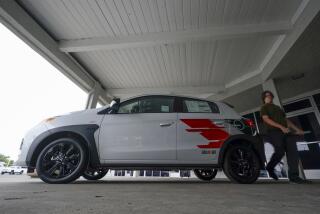Cost isn’t indicator of safety in ragtops
When it comes to buying a crash-worthy convertible, paying more doesn’t always get you more, researchers have found.
With starting prices above $39,000, the BMW 3 Series and the Audi A4 Cabriolet were among the most expensive of 10 ragtops tested by the Insurance Institute for Highway Safety, yet they placed near the bottom of the safety rankings.
The institute rated the costly Saab 9-3 and the Volvo C70 -- which list at between $35,000 and $40,000 -- as the convertibles giving occupants the best chances of surviving accidents.
But entries from Volkswagen and Mitsubishi priced below $30,000 got high marks too.
“While the top two Safety Pick winners are relatively expensive, price doesn’t necessarily predict good crash test ratings,” the institute said in a report due to be released today.
The institute, an industry-funded research body, publishes crash-test ratings in an effort to push auto makers to design safer vehicles.
Because convertibles are aimed at a niche market, the institute had never performed crash tests on them. Sales of drop-tops have accelerated in recent years, convincing the group that the time had come.
Institute President Adrian Lund said the group “also wanted to evaluate a group of vehicles that automakers wouldn’t expect us to test to see if crashworthiness improvements in mainstream cars also are being built into convertibles.”
“For the most part,” he said, “we found that this was happening.”
The vehicles were tested for their ability to protect occupants during front, side and rear-end impacts at speeds of up to 40 miles per hour.
The lowest-rated car was the Pontiac G6 from General Motors Corp., which received “marginal” ratings for both side and rear collisions and an “acceptable” rating for head-on impacts. The car’s compartment held up well during the frontal crash, the institute reported, but the driver’s seat came loose on one side, causing a crash dummy’s head to slide around the air bag and hit the dashboard.
“We’ve rarely seen a dummy’s head hit the instrument panel in our frontal test,” Lund said.
GM said the Pontiac convertible was in compliance with all federal safety standards. Although the seat moved during the test, it “remained in place and provided good protection,” the automaker said.
The Audi 4 and BMW 3 series convertibles performed well in the institute’s front-end tests but received marginal ratings for side crashes and poor ratings for rear-end impacts.
Subpar performance in rear-end crashes was typical of all of the tested models except for the top-rated cars from Saab and Volvo.
“It isn’t hard or expensive to design a seat to prevent neck injury in a rear-end crash,” said Lund, noting that Audi, Ford and Volkswagen offer such seats in other vehicles -- though not in the convertible models that were tested.
The Audi has a starting list price of $39,100, while the BMW starts at $43,200, according to Edmunds.com, an auto data tracker.
BMW contended that safety restraints in its vehicle weren’t properly adjusted in the rear-end tests, leading to the poor results. The German automaker said BMWs were built to meet a wide variety of crash-test requirements around the globe.
The institute didn’t rate the convertibles for rollover protection. Like the other European models, the Audi and BMW convertibles are equipped with pop-up roll bars, which can provide greater protection during a rollover accident.
Because they lack the added protection of a rigid top, convertibles have long been considered more dangerous than hardtop vehicles. Recent improvements in safety technology have done much to reduce that disparity, Lund said.
“We don’t think they’re safer than hardtops,” he said, but “they’re not as risky as a lot of people thought they were and not as risky as they used to be.”
The institute’s ratings don’t directly affect insurance rates, but safety -- or lack of it -- is becoming an increasingly important item on a car shopper’s checklist.
“Vehicles’ safety ratings are starting to figure very highly in vehicle advertising because manufacturers realize that they’re a selling point,” said Joanne Helperin, senior features editor at Edmunds.com. “People want a safe car. For some people it may be a deciding factor.”
*
*
Begin text of infobox
Crash testing
*--* Front Side Rear-end Base Make and model crash crash crash price* Saab 9-3 Good Good Good $37,495 Volvo C70 Good Good Good 39,090 Mitsubishi Eclipse Spyder Good Good Marginal 25,389 Volkswagen Eos Good Good Marginal 28,110 Chrysler Sebring Good Good Poor 25,470 Toyota Camry Solara Good Acceptable Poor 27,190 Ford Mustang Acceptable Good Poor 24,075 BMW 3 series Good Marginal Poor 43,200 Audi A4 Cabriolet Good Marginal Poor 39,100 Pontiac G6 Acceptable Marginal Marginal 28,750
*--*
*2007 model year except for Chrysler Sebring, which is 2008
**
Sources: Insurance Institute for Highway Safety, Edmunds.com






